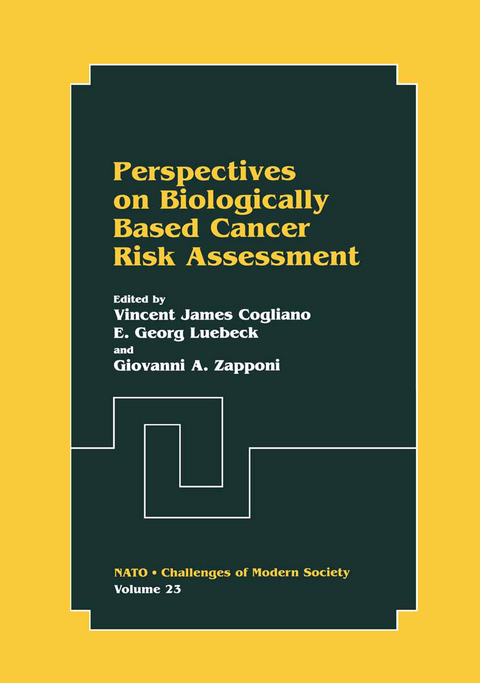
Perspectives on Biologically Based Cancer Risk Assessment
Springer-Verlag New York Inc.
978-1-4613-7149-6 (ISBN)
1. Introduction.- 1.1. Dose-Response Assessment in Nato Countries.- 1.2. Future Directions in Dose-Response Assessment.- 1.3. Brief Considerations on Some Commonly Used Parameters.- 1.4. Structure of this Report.- 1.5. References.- 2. The Biological Basis of Cancer.- 2.1. Introduction.- 2.2. Cell Proliferation.- 2.3. Cell Proliferation and Mutation.- 2.4. Differences in Susceptibility.- 2.5. Mechanisms of Inhibition in Mutagenesis and Carcinogenesis.- 2.6. References.- 3. Sources of Data For Cancer Risk Assessment.- 3.1. Introduction.- 3.2. In Vitro and Short Term Testing.- 3.3. Trends in Animal Toxicology Testing.- 3.4. Cell Proliferation.- 3.5. Sources of Toxicokinetic Data.- 3.6. Inter- and Intra-Species Variability.- 3.7. References.- 4. Use of Biochemical and Molecular Biomarkers For Cancer Risk Assessment in Humans.- 4.1. Introduction.- 4.2. The Initiatory Complex and its Modulators.- 4.3. The Determinants of the Clonal Expansion of the Initiated Cells.- 4.4. Adjuvant Determinants of the Clonal Expansion.- 4.5. Conclusion.- 4.6. Acknowledgments.- 4.7. References.- 5. The Multistage Model of Carcinogenesis: A Critical Review of its Use.- 5.1. Introduction.- 5.2. Historical Antecedents of the Multistage Model.- 5.3. The Armitage-Doll Multistage Model.- 5.4. Derivation, Rationale and Mathematical Form of the Model.- 5.5. The “Linearized Multistage Model”.- 5.6. Time-Dependent Non-Constant Exposure Patterns: Their Influence on Multistage-Derived Risk Estimates.- 5.7. Consideration of Pharmakokinetics in Multistage Modeling.- 5.8. The Problem of Multiple Exposure: Multistage Carcinogenesis Theory and Additive and Multiplicative Models.- 5.9. Critical Review of the Model.- 5.10. Discussion.- 5.11. References.- 6. Biologically Based Models of Carcinogenesis.- 6.1.Introduction.- 6.2. A Brief History of Biologically-Based Cancer Models.- 6.3. Two-Mutation Clonal Expansion Model.- 6.4. Modes of Action of Carcinogens.- 6.5. Quantitative Formulation of the Model.- 6.6. Likelihood Construction and Estimation.- 6.7. Quantitative Analysis of Intermediate Lesions.- 6.8. Toxicokinetics in Biologically Based Risk Assessment.- 6.9. Interspecies Extrapolation.- 6.10. Implications for Low-Dose Extrapolation.- 6.11. References.- 7. Statistical Issues in the Application of Multistage and Biologically Based Models.- 7.1. Introduction.- 7.2. Characterization Of Models.- 7.3. Statistical Inference.- 7.4. Design Considerations for Low-Dose Problems.- 7.5. Sensitivity Analysis and Physiologically Based Toxicokinetic Modeling.- 7.6. Discussion.- 7.7. References.- 8. Informative Case Studies.- 8.1. Radon, Cigarette Smoke, and Lung Cancer: The Colorado Plateau Uranium Miners’ Cohort.- 8.2. Modeling Colon Cancer.- 8.3. Quantitative Analysis of Enzyme Altered Foci (EAF).- 8.4. The Role of Cell Proliferation in Urinary Bladder Carcinogenesis.- 8.5. N-Nitrosomorpholine: Comparison of Multistage Model and Two-Event Clonal Expansion Model.- 8.6. Calculation of Tetrachloroethylene Risk Estimates.- 8.7. Considerations for Benzene Toxicokinetic Extrapolation.- 8.8. References.- 8.9. Appendix A.- 9. Conclusions and Recommendations.- 9.1. Introduction.- 9.2. What does Each Source of Experimental Data Contribute to our Knowledge and Ability to Model?.- 9.3. What Kinds of Information are Needed to Develop a Biologically Based Model?.- 9.4. How does Linearity Enter into Empirical Models and Biologically Based Models?.- 9.5. How does a Biologically Based Model Help Us Understand Intraspecies Variability?.- 9.6. How D
does a Biologically Based Model Help UsUnderstand Interspecies Variability?.- 9.7. What are the Uncertainties Associated with a Biologically Based Model?.- Contributors.
| Erscheint lt. Verlag | 25.9.2012 |
|---|---|
| Reihe/Serie | Nato - Challenges of Modern Society ; 23 |
| Zusatzinfo | XIII, 319 p. |
| Verlagsort | New York, NY |
| Sprache | englisch |
| Maße | 178 x 254 mm |
| Themenwelt | Sachbuch/Ratgeber ► Natur / Technik ► Natur / Ökologie |
| Medizin / Pharmazie ► Medizinische Fachgebiete ► Onkologie | |
| Medizin / Pharmazie ► Medizinische Fachgebiete ► Pharmakologie / Pharmakotherapie | |
| Naturwissenschaften ► Biologie ► Ökologie / Naturschutz | |
| Naturwissenschaften ► Geowissenschaften | |
| ISBN-10 | 1-4613-7149-X / 146137149X |
| ISBN-13 | 978-1-4613-7149-6 / 9781461371496 |
| Zustand | Neuware |
| Haben Sie eine Frage zum Produkt? |
aus dem Bereich


